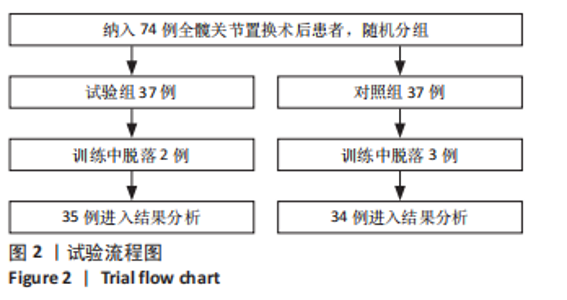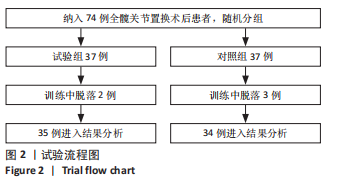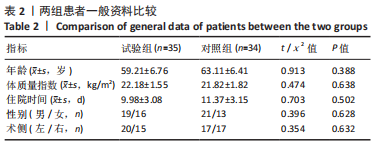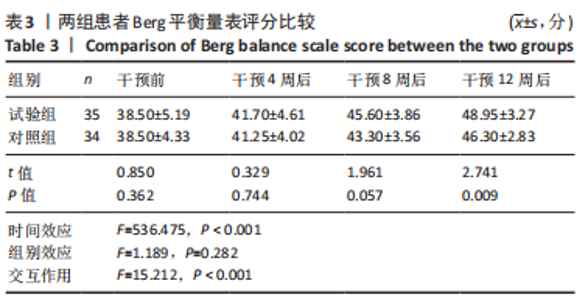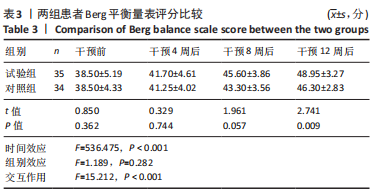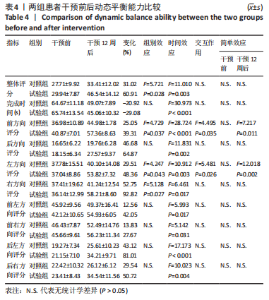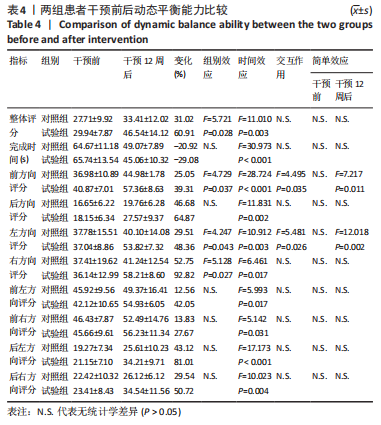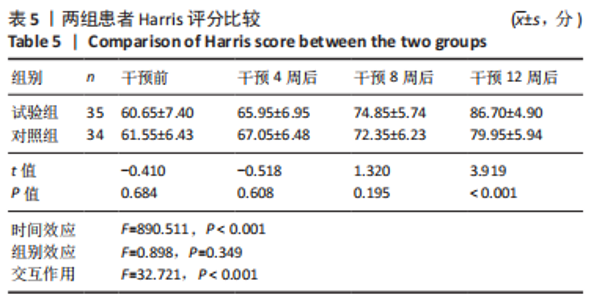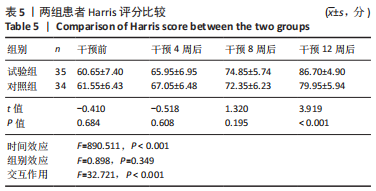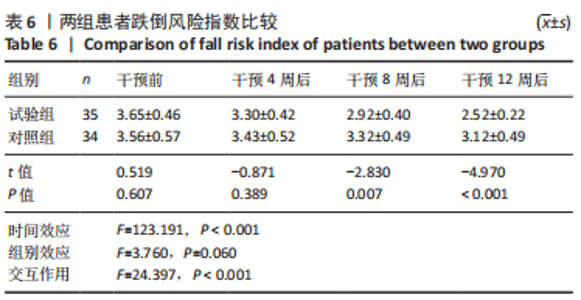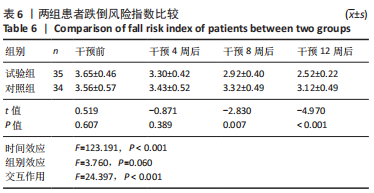Chinese Journal of Tissue Engineering Research ›› 2024, Vol. 28 ›› Issue (18): 2840-2845.doi: 10.12307/2024.055
Previous Articles Next Articles
Body weight support Tai Chi footwork improves balance function after total hip arthroplasty
Zhang Liying1, Ding Yuwu2, Yu Xiaoming2, Liao Wangsheng3, Wang Jiening1, 2
- 1The Seventh Clinical School of Medicine, Shanghai University of Traditional Chinese Medicine, Shanghai 201210, China; 2Rehabilitation Medicine Center, Shanghai Seventh People’s Hospital, Shanghai 200137, China; 3Department of Rehabilitation, Fuzhou Second Hospital, Fuzhou 350007, Fujian Province, China
-
Received:2023-03-14Accepted:2023-05-08Online:2024-06-28Published:2023-08-24 -
Contact:Wang Jiening, Master, Professor, The Seventh Clinical School of Medicine, Shanghai University of Traditional Chinese Medicine, Shanghai 201210, China; Rehabilitation Medicine Center, Shanghai Seventh People’s Hospital, Shanghai 200137, China -
About author:Zhang Liying, Master, Physiotherapists, The Seventh Clinical School of Medicine, Shanghai University of Traditional Chinese Medicine, Shanghai 201210, China -
Supported by:Shanghai Municipal Health Commission Chinese Medicine Research Project, No. 2020LP004 (to YXM); Pudong New Area “National Traditional Chinese Medicine Development Comprehensive Reform Experimental Zone” Construction Project, No. PDZY-2022-0702 (to WJN); Health and Family Planning Research Project of Pudong New Area Health Committee, No. PW2023B-14 (to DYW)
CLC Number:
Cite this article
Zhang Liying, Ding Yuwu, Yu Xiaoming, Liao Wangsheng, Wang Jiening. Body weight support Tai Chi footwork improves balance function after total hip arthroplasty[J]. Chinese Journal of Tissue Engineering Research, 2024, 28(18): 2840-2845.
share this article
Add to citation manager EndNote|Reference Manager|ProCite|BibTeX|RefWorks
| [1] KRAUS K, DILLEY J, ZIEMBA-DAVIS M, et al. Procedure Duration, Time Under Anesthesia, and Readmissions in Direct Anterior and Posterior Approach Total Hip Arthroplasty. J Arthroplasty. 2022;37(12):2387-2393. [2] 谷斌, 陈绪娜, 张千坤, 等. 全髋关节置换术后患者渐进式平衡训练方案的制订与应用 [J]. 中华护理杂志,2020,55(10):1458-1464. [3] DEERE K, WHITEHOUSE M, KUNUTSOR S, et al. How long do revised and multiply revised hip replacements last? A retrospective observational study of the National Joint Registry. Lancet Rheumatol. 2022;4(7):e468-e479. [4] RUPP M, LAU E, KURTZ S, et al. Projections of Primary TKA and THA in Germany From 2016 Through 2040. Clin Orthop Relat Res. 2020;478(7):1622-1633. [5] LABANCA L, CIARDULLI F, BONSANTO F, et al. Balance and proprioception impairment, assessment tools, and rehabilitation training in patients with total hip arthroplasty: a systematic review. BMC Musculoskelet Disord. 2021;22(1):1055. [6] 闵春燕. 全髋关节置换术后患者跌倒恐惧及影响因素研究[D]. 石河子:石河子大学,2022. [7] 王恬, 刘晓宇, 陆海英, 等. 全髋关节置换术后患者早期抗阻训练的最佳证据总结 [J]. 中华护理杂志,2020,55(10):1476-1483. [8] 陈少华, 王永萍, 陆泽丰, 等. 单侧髋关节置换术后患者进行平衡功能训练对下肢运动功能的影响 [J]. 反射疗法与康复医学,2022,3(8):69-72+76. [9] 袁博, 李开南, 贾子善. 不同模式平衡障碍康复机器人训练老年全髋关节置换后的效果比较 [J]. 中国组织工程研究,2022,26(36):5826-5830. [10] HESSE S, WERNER C, SEIBEL H, et al. Treadmill training with partial body-weight support after total hip arthroplasty: a randomized controlled trial. Arch Phys Med Rehabil. 2003;84(12):1767-1773. [11] ZENG R, LIN J, WU S, et al. A randomized controlled trial: preoperative home-based combined Tai Chi and Strength Training (TCST) to improve balance and aerobic capacity in patients with total hip arthroplasty (THA). Arch Gerontol Geriatr. 2015;60(2):265-271. [12] KIM H, KIM Y, LEE S. Effects of therapeutic Tai Chi on balance, gait, and quality of life in chronic stroke patients. Int J Rehabil Res. 2015;38(2):156-161. [13] MORTAZAVI H, TABATABAEICHEHR M, GOLESTANI A, et al. The Effect of Tai Chi Exercise on the Risk and Fear of Falling in Older Adults: a Randomized Clinical Trial. Mater Sociomed. 2018;30(1):38-42. [14] SOUSA C, BARELA J, PRADO-MEDEIROS C, et al. The use of body weight support on ground level: an alternative strategy for gait training of individuals with stroke. J Neuroeng Rehabil. 2009;6:43. [15] LI F. Tai Ji Quan: Moving for Better BalanceTransforming traditional Tai Ji Quan techniques into integrative movement therapy. J Sport Health Sci. 2014;3(1):9-15. [16] YU X, JIN X, LU Y, et al. Effects of Body Weight Support-Tai Chi Footwork Training on Balance Control and Walking Function in Stroke Survivors with Hemiplegia: A Pilot Randomized Controlled Trial. Evid Based Complement Alternat Med. 2020; 2020:9218078. [17] SKOFFER B, DALGAS U, MECHLENBURG I. Progressive resistance training before and after total hip and knee arthroplasty: a systematic review. Clin Rehabil. 2015; 29(1):14-29. [18] MITROVIC D, DAVIDOVIC M, ERCEG P, et al. The effectiveness of supplementary arm and upper body exercises following total hip arthroplasty for osteoarthritis in the elderly: a randomized controlled trial. Clin Rehabil. 2017;31(7):881-890. [19] 陈丽萍. 连续被动活动练习器在髋膝关节术后的应用[J]. 齐鲁护理杂志, 2009,15(6):92-93. [20] 常海宽. 下肢机器人联合减重步行训练在脑梗死偏瘫患者中的应用效果[J]. 医疗装备,2022,35(21):122-124. [21] FRANCESCHINI M, CARDA S, AGOSTI M, et al. Walking after stroke: what does treadmill training with body weight support add to overground gait training in patients early after stroke?: a single-blind, randomized, controlled trial. Stroke. 2009;40(9):3079-3085. [22] 柴丽, 王梅. 基于ICF脑卒中核心分类组合评价轨道减重步行训练对脑卒中患者下肢运动功能康复的效果[J]. 中国康复理论与实践,2022,28(6):653-658. [23] 陈玉枝. 24式简化太极拳技术动作力学分析[J]. 祖国,2019(7):97+118. [24] 王红雨, 张林. 24式简化太极拳对老年人平衡功能的影响 [J]. 中国老年学杂志,2013,33(13):3011-3013. [25] JOGI P, SPAULDING S, ZECEVIC A, et al. Comparison of the original and reduced versions of the Berg Balance Scale and the Western Ontario and McMaster Universities Osteoarthritis Index in patients following hip or knee arthroplasty. Physiother Can. 2011;63(1):107-114. [26] MELZER I, BENJUYA N, KAPLANSKI J, et al. Association between ankle muscle strength and limit of stability in older adults. Age Ageing. 2009;38(1):119-123. [27] 李擎, 谢连红, 杨坚, 等. 膝骨性关节炎患者动态平衡能力变化[J]. 中国组织工程研究,2013,17(22):4176-4180. [28] HERSNAES P, GROMOV K, OTTE K, et al. Harris Hip Score and SF-36 following metal-on-metal total hip arthroplasty and hip resurfacing - a randomized controlled trial with 5-years follow up including 75 patients. BMC Musculoskelet Disord. 2021;22(1):781. [29] 史凌云, 薛巧云, 李思琦, 等. 发育性髋关节脱位病人治疗后功能恢复情况的生存分析[J]. 护理研究,2020,34(24):4338-4343. [30] ZHAO R, LU J, XIAO Y, et al. Effects of Gaze Stabilization Exercises on Gait, Plantar Pressure, and Balance Function in Post-Stroke Patients: A Randomized Controlled Trial. Brain Sci. 2022;12(12):1-12. [31] WAYNE P, BERKOWITZ D, LITROWNIK D, et al. What do we really know about the safety of tai chi?: A systematic review of adverse event reports in randomized trials. Arch Phys Med Rehabil. 2014;95(12):2470-2483. [32] LI F, HARMER P, FITZGERALD K, et al. Tai chi and postural stability in patients with Parkinson’s disease. N Engl J Med. 2012; 366(6): 511-519. [33] GU Q, WU S, ZHENG Y, et al. Tai Chi Exercise for Patients with Chronic Heart Failure: A Meta-analysis of Randomized Controlled Trials. Am J Phys Med Rehabil. 2017;96(10):706-716. [34] MEHRHOLZ J, THOMAS S, ELSNER B. Treadmill training and body weight support for walking after stroke. Cochrane Database Syst Rev. 2017;8(8):CD002840. [35] HUANG S, YU X, LU Y, et al. Body weight support-Tai Chi footwork for balance of stroke survivors with fear of falling: A pilot randomized controlled trial. Complement Ther Clin Pract. 2019;37:140-147. [36] TAKESHIMA N, ISLAM M, KATO Y, et al. Effects of 12 Weeks of Tai Chi Chuan Training on Balance and Functional Fitness in Older Japanese Adults. Sports (Basel). 2017;5(2):1-8. [37] 朱彬. 陈式太极拳对大学生膝踝关节肌肉力量及本体感觉影响的实验研究[D]. 福州:福建师范大学,2019. [38] 郑永智, 李孟飞, 周世博. 太极拳对早期膝骨关节炎步态参数的影响及疗效观察[J]. 中医药临床杂志,2019,31(4):766-769. [39] 张琥, 张旻, 龚幼波, 等. 太极拳对早期膝骨关节炎患者步态影响的研究[J]. 中医正骨,2018,30(9):34-38. [40] 姜林鸿, 齐瑞, 赵莉娟, 等. 太极拳运动对卒中后运动功能障碍影响及其机制的研究进展[J]. 中国康复医学杂志,2022,37(8):1116-1120. [41] CHEN J, XUE X, XU J, et al. Emerging Trends and Hotspots in Tai Chi Fall Prevention: Analysis and Visualization. Int J Environ Res Public Health. 2022;19(14):1-17. [42] GALLANT M, TARTAGLIA M, HARDMAN S, et al. Using Tai Chi to Reduce Fall Risk Factors Among Older Adults: An Evaluation of a Community-Based Implementation. J Appl Gerontol. 2019;38(7):983-998. |
| [1] | Min Meipeng, Wu Jin, URBA RAFI, Zhang Wenjie, Gao Jia, Wang Yunhua, He Bin, Fan Lei. Role and significance of artificial intelligence preoperative planning in total hip arthroplasty [J]. Chinese Journal of Tissue Engineering Research, 2024, 28(9): 1372-1377. |
| [2] | Zhang Xihui, Li Zhengrong, Li Shineng, Xing Zengyu, Wang Jiao. Effect of rehabilitation training guided by Pro-kin balance system on proprioception and balance function of the affected knee after anterior cruciate ligament reconstruction [J]. Chinese Journal of Tissue Engineering Research, 2024, 28(8): 1259-1264. |
| [3] | Pan Yunchun, Wei Hongjun, Ren Guoqing, Zhang Qiliang. Comparison of gait and hip ambulation ability after total hip arthroplasty through different approaches [J]. Chinese Journal of Tissue Engineering Research, 2024, 28(18): 2846-2851. |
| [4] | Zhang Kai, Guo Zhuotao, Ma Qiaoqiao, Zha Guochun, Guo Kaijin. Accuracy and influencing factor of artificial intelligence planning system in patients undergoing total hip arthroplasty [J]. Chinese Journal of Tissue Engineering Research, 2024, 28(12): 1863-1868. |
| [5] | Ke Yuqi, Chen Changjian, Wu Hao, Zheng Lianjie. Comparison of 12-month follow-up results of primary total hip arthroplasty between modified direct anterior approach and direct anterior approach [J]. Chinese Journal of Tissue Engineering Research, 2023, 27(9): 1377-1382. |
| [6] | Li Yaping, Liu Hong, Gao Zhen, Chen Xiaolin, Huang Wujie, Jiang Zheng. Three-dimensional motion analysis of lower limb biomechanical performance in Tai Chi practitioners accompanied by knee joint pain [J]. Chinese Journal of Tissue Engineering Research, 2023, 27(4): 520-526. |
| [7] | Yan Ruizhong, Li Jiahui, Lin Shuzhong, Wu Xiaogang, Guo Zhijian, Liu Wenqi, Liu Qiang. Effect of pelvic tilt on the stress at the acetabular side in standing position after total hip arthroplasty: finite element analysis [J]. Chinese Journal of Tissue Engineering Research, 2023, 27(36): 5795-5800. |
| [8] | Guo Zhuotao, Zhang Kai, Zha Guochun, Guo Kaijin. A matched controlled trial of lumbar fusion effect on mid-term outcomes after total hip arthroplasty [J]. Chinese Journal of Tissue Engineering Research, 2023, 27(36): 5801-5805. |
| [9] | Li Qizhe, Kong Yao, Fan Jiannan, Wu Yeting, Yang Hua, Xiao Yinlong, Sun Hong. Measurement and clinical significance of acetabular parameters in the Guizhou population [J]. Chinese Journal of Tissue Engineering Research, 2023, 27(36): 5856-5863. |
| [10] | Chen Peng, Wang Ling, Dong Shiyu, Ding Yue, Jia Shaohui, Kou Xianjuan, Zheng Cheng. Effects of whole-body vibration training on anterior cruciate ligament reconstruction: a meta-analysis [J]. Chinese Journal of Tissue Engineering Research, 2023, 27(36): 5875-5883. |
| [11] | You Aijia, Li Wenjie, Zhou Junli, Li Chun. Systematic evaluation of six dressings on wound safety following total hip and knee arthroplasty [J]. Chinese Journal of Tissue Engineering Research, 2023, 27(3): 486-492. |
| [12] | Zhang Hang, He Qiang, Liu Qing, He Yunli, Wang Tao, Feng Zhe, Zhang Qian, He Sen. Comparative analysis of artificial intelligence and two-dimensional digital template preoperative planning-assisted total hip arthroplasty to predict prosthesis size [J]. Chinese Journal of Tissue Engineering Research, 2023, 27(29): 4620-4627. |
| [13] | Li Junran, Zhai Jingxiu, Zhao Hongbo, Wang Lei, Wang Hongrun, Liang Junsheng, Li Ligeng. Assistance of traction table for total hip arthroplasty through the direct anterior approach for treating femoral neck fracture in the elderly [J]. Chinese Journal of Tissue Engineering Research, 2023, 27(27): 4312-4317. |
| [14] | Ren Yi, Lu Ming, Qin Kunpeng, Zhang Hui, Gao Weilu, Li Yetian, Wang Jun, Yin Li, Yin Zongsheng. OrthoPilot navigation system assisted total hip arthroplasty improves the accuracy and safety of acetabular cup placement [J]. Chinese Journal of Tissue Engineering Research, 2023, 27(27): 4318-4323. |
| [15] | Zhou Hongxing, Zhang Baojian, Yuan Xiangsheng. Recent evaluation of individual biological acetabular cup application in hip revision [J]. Chinese Journal of Tissue Engineering Research, 2023, 27(22): 3521-3525. |
| Viewed | ||||||
|
Full text |
|
|||||
|
Abstract |
|
|||||
